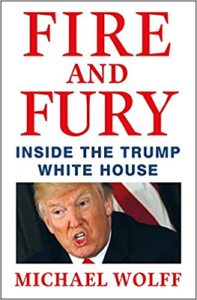“Fire and Fury” Through A Communications Lens: The Tipping Point in the Trump Presidency?
 Simon Erskine Locke, Founder & CEO, CommunicationsMatchTM We’ve heard it all before – the chaos, the narcissism, the comparisons to a child, the questions about mental competency – so why does “Fire and Fury: Inside The Trump White House” by Michael Wolff matter?To date nothing seems to have changed the minds of Trump supporters. Candidate Trump’s comment that he could stand on New York’s Fifth Avenue and shoot someone and not lose voters – has held true with his political base.Will this book change their opinions? Probably not in the context of a world in which Hilary Clinton, Nancy Pelosi, Barack Obama and Democrats in general are seen by the right as Devils incarnate. Realistically, no matter the flaws, supporting Trump will continue to be the only option given a binary choice.The soap opera details of Trump’s election and first year in the White House outlined in the book are important to the other 60-plus percent of Americans, whose participation in the coming mid-term and next Presidential elections will determine his fate.Looked at through a communications lens – what has largely been hearsay has been confirmed by a credible (if salacious) source.President Trump and his surrogates’ communications efforts to deny the Wolff narrative – which in any other White House might have reduced its impact – have served to lend it credibility. Who could have imagined a President claiming to be a “stable genius.”
Simon Erskine Locke, Founder & CEO, CommunicationsMatchTM We’ve heard it all before – the chaos, the narcissism, the comparisons to a child, the questions about mental competency – so why does “Fire and Fury: Inside The Trump White House” by Michael Wolff matter?To date nothing seems to have changed the minds of Trump supporters. Candidate Trump’s comment that he could stand on New York’s Fifth Avenue and shoot someone and not lose voters – has held true with his political base.Will this book change their opinions? Probably not in the context of a world in which Hilary Clinton, Nancy Pelosi, Barack Obama and Democrats in general are seen by the right as Devils incarnate. Realistically, no matter the flaws, supporting Trump will continue to be the only option given a binary choice.The soap opera details of Trump’s election and first year in the White House outlined in the book are important to the other 60-plus percent of Americans, whose participation in the coming mid-term and next Presidential elections will determine his fate.Looked at through a communications lens – what has largely been hearsay has been confirmed by a credible (if salacious) source.President Trump and his surrogates’ communications efforts to deny the Wolff narrative – which in any other White House might have reduced its impact – have served to lend it credibility. Who could have imagined a President claiming to be a “stable genius.” Furthermore, the book resonates – not because anything is a surprise – but because it confirms prior media coverage and, as a result, embeds negative perceptions about Trump even deeper into the national mindset.As communicators we know the importance of credibility. How reputation and trust have to be earned with audiences for messages to be accepted. We know a boy (company or organization) can only cry wolf a certain number of times before we stop listening. That’s the point we have reached with this Presidency.One of the key takeaways is to remind us that lying, whether by organizations, politicians, companies or communicators isn’t an effective communications strategy.Yes. It may work a few times, but eventually the truth catches up. With every falsehood, credibility is undermined. Eventually, audiences stop believing… everything.Changing perceptions becomes harder and harder the further down the rabbit hole of untruth.Social science shows that people tend to double down when information doesn’t fit the mental frameworks we use to process information. In other words, we often ignore or deny facts if they contradict our beliefs.It was precisely this phenomenon that got Trump elected. Questions about the President’s qualifications and behaviors were simply dismissed, at best as politics, or at worst, as part of a left-wing conspiracy.It is somewhat ironic, then that within a year of becoming President, Trump is arguably on the path to becoming a lame duck for the same reasons. This time around, it will be independents and progressives, who will discount information that does not fit with their worldview – that includes potential achievements.A stock market at record highs, a strong economy and low jobless rate would normally cover a multitude of sins. But not, if there is no trust. Think financial industry after the financial crisis. Politics after Nixon.While we need to be careful to overstate the importance of “Fire & Fury” – it will likely prove to be a tipping point for this Presidency and all that comes next.As communicators, it also serves as a case study of how hard it is to earn trust and how easy it is to lose it – even if you hold the highest office in the land. [author]About: CommunicationsMatch offers communications & PR agency search tools and resources that help companies find, shortlist and engage communications agencies, consultants and freelancers by industry and communications expertise, location and size. The site has 5,000 agency and professional profiles in areas including: crisis communications, public relations, internal communications, government affairs, investor relations, content marketing, social media, SEO, website development, photography and video. CommunicationsMatch recently launched a next day Crisis & Opinion Survey tool for PR and communications professionals. Prior to founding CommunicationsMatch, Locke held senior corporate communications roles at Prudential Financial, Morgan Stanley and Deutsche Bank and founded communications consultancies. [/author]
Furthermore, the book resonates – not because anything is a surprise – but because it confirms prior media coverage and, as a result, embeds negative perceptions about Trump even deeper into the national mindset.As communicators we know the importance of credibility. How reputation and trust have to be earned with audiences for messages to be accepted. We know a boy (company or organization) can only cry wolf a certain number of times before we stop listening. That’s the point we have reached with this Presidency.One of the key takeaways is to remind us that lying, whether by organizations, politicians, companies or communicators isn’t an effective communications strategy.Yes. It may work a few times, but eventually the truth catches up. With every falsehood, credibility is undermined. Eventually, audiences stop believing… everything.Changing perceptions becomes harder and harder the further down the rabbit hole of untruth.Social science shows that people tend to double down when information doesn’t fit the mental frameworks we use to process information. In other words, we often ignore or deny facts if they contradict our beliefs.It was precisely this phenomenon that got Trump elected. Questions about the President’s qualifications and behaviors were simply dismissed, at best as politics, or at worst, as part of a left-wing conspiracy.It is somewhat ironic, then that within a year of becoming President, Trump is arguably on the path to becoming a lame duck for the same reasons. This time around, it will be independents and progressives, who will discount information that does not fit with their worldview – that includes potential achievements.A stock market at record highs, a strong economy and low jobless rate would normally cover a multitude of sins. But not, if there is no trust. Think financial industry after the financial crisis. Politics after Nixon.While we need to be careful to overstate the importance of “Fire & Fury” – it will likely prove to be a tipping point for this Presidency and all that comes next.As communicators, it also serves as a case study of how hard it is to earn trust and how easy it is to lose it – even if you hold the highest office in the land. [author]About: CommunicationsMatch offers communications & PR agency search tools and resources that help companies find, shortlist and engage communications agencies, consultants and freelancers by industry and communications expertise, location and size. The site has 5,000 agency and professional profiles in areas including: crisis communications, public relations, internal communications, government affairs, investor relations, content marketing, social media, SEO, website development, photography and video. CommunicationsMatch recently launched a next day Crisis & Opinion Survey tool for PR and communications professionals. Prior to founding CommunicationsMatch, Locke held senior corporate communications roles at Prudential Financial, Morgan Stanley and Deutsche Bank and founded communications consultancies. [/author]